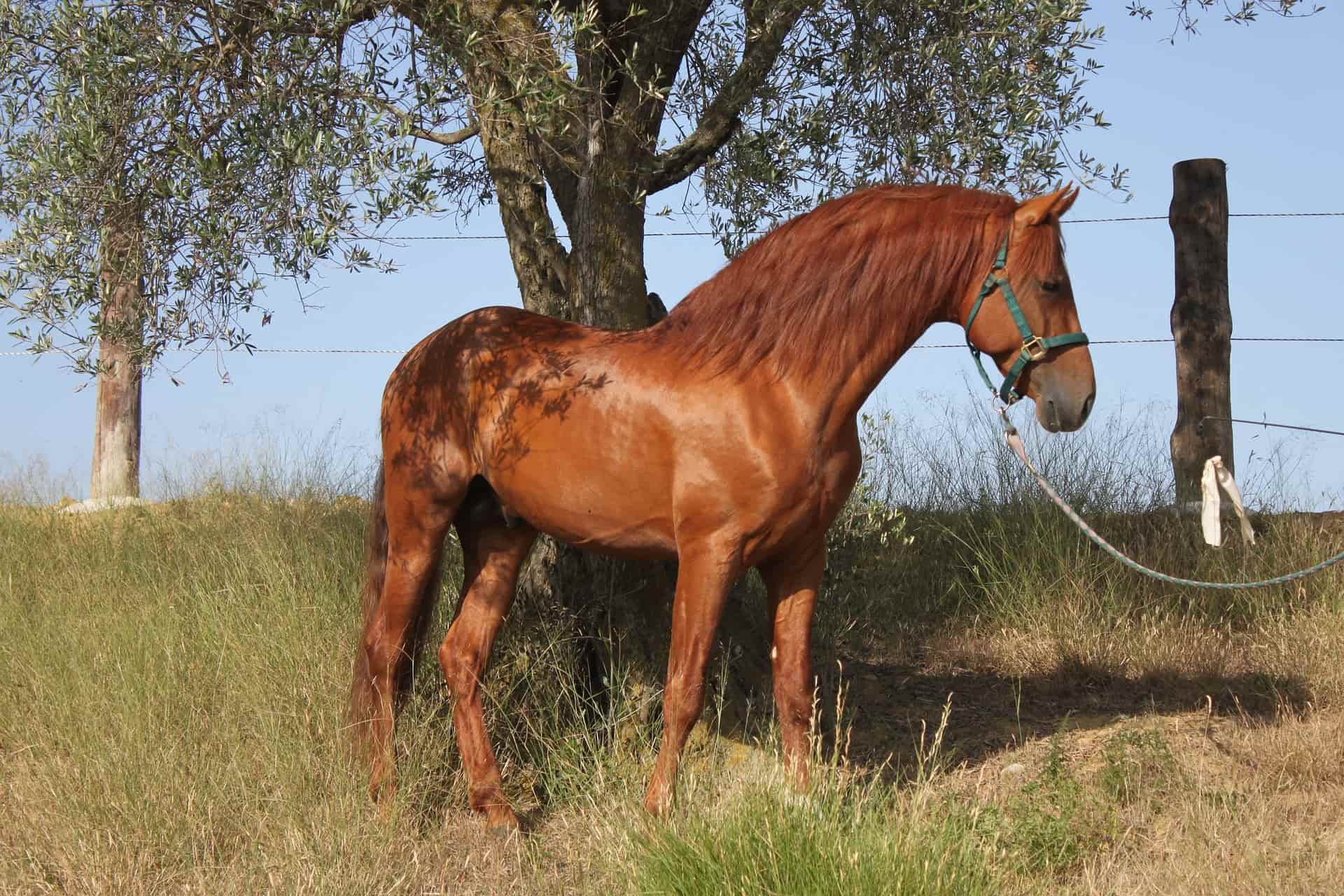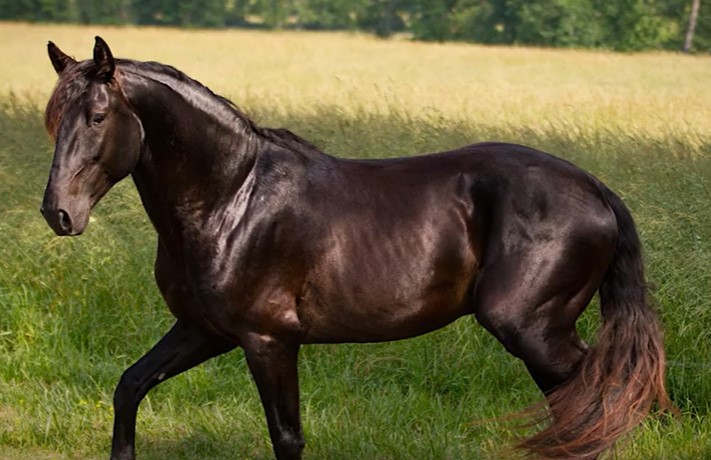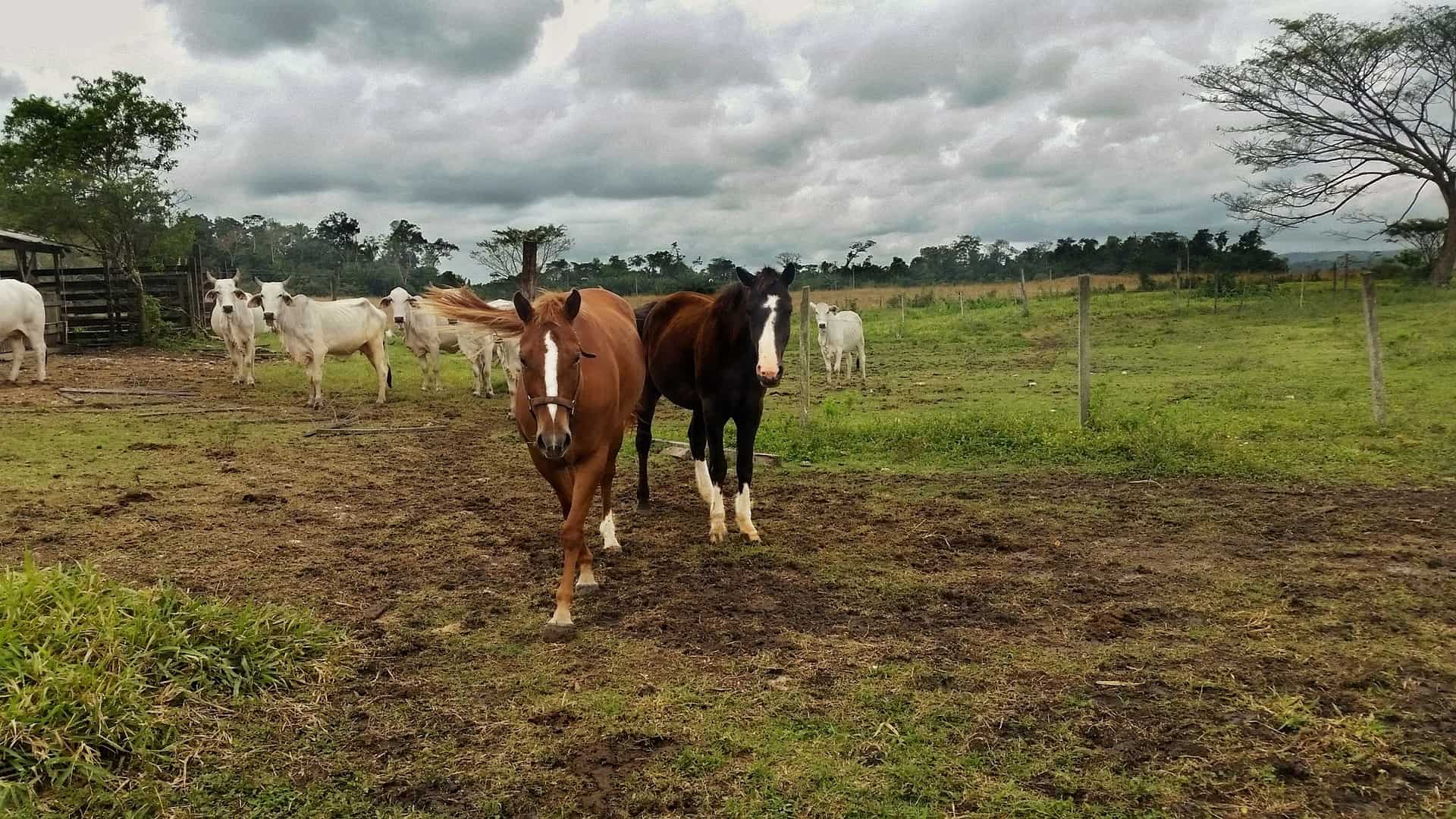The silvery sheen of roan horses has made them a hot commodity among enthusiasts who place a high estimate on appearances. The manifestation of single gene, the roan coloration was once rare. However because of careful breeding efforts, the community of horse lovers managed to proliferate the beautiful roan colors.
It’s worth knowing though that although some coat colors might look roan, it’s possible that they aren’t. So how can you tell a true roan from a lookalike? Here’s everything about roans, explained.
What is a True Roan Horse?

Also called ‘classic roan’, the true roan coloring may appear to have a silvery sheen over the coat. This is because roan horses have a two-tone coat that combines colored and white hairs. The equally distributed hairs give the horse a metallic, silvery appearance that roans are best known for.
To identify true roan horses, you’d have to take a closer look at the distribution of its white hairs. Generally, classic roan horses have a solid colored coat on its head and its points. This pertains to the ‘tips’ of the horse, including its ears, lower legs mane and tail.
In the winter, it’s possible for roans to take on a darker hue. This is because the colored hairs will tend to grow and thicken as the horse grows its winter coat, while the white hairs remain the same length. As a result, the horse may appear much darker during the cold months.
Another thing about roans is that they don’t get lighter over time. In fact, many roans may end up darkening with time. Even more interesting is that when a roan suffers a cut or a break in its skin, the colored hairs will dominate the resulting scar.
These colored spots or darker patches are called ‘corn marks.’ Keep in mind though that some roans will have corn marks on their body regardless of whether or not they were injured or wounded.
Roan Genetics
There is a specific genetic makeup that manifests the roan coloration. The presence of a single dominant RN allele guarantees a roan colored foal. To inherit this gene, at least one of the foal’s parents should have been a true roan horse.
The best chance of breeding a true roan horse then would be to cross a roan sire with a roan mare. Roan parents both carrying a dominant RN allele (RN/n) have a 50% chance of producing a homozygous roan (RN/RN), a 25% chance of producing a heterozygous roan (RN/n), and a 25% chance of producing a non-roan horse (n/n).
Essentially, a roan offspring will only need one dominant RN gene to have the roan color pattern. Homozygous roan horses and heterozygous roans do not differ in appearance and are both true roans. When born, a roan horse will already showcase its roan coat. As it ages, the horse may become darker, but it will appear roan from cradle to grave.
Today, the roan gene can be found in various horse breeds including the Quarter horse, American Paint horse, Peruvian Paso, Paso Fino, Tennessee Walking horse, Welsh Pony, and the Belgian. Not all horse breeds can manifest the colorway however as varieties like the Thoroughbred and the Arabian do no possess the roan gene.
To find out if your horse has roan genetic markers, you’d have to get it tested. The roan zygosity test is strongly recommended by the American Quarter Horse Association for quarter horses. The American Roan Horse Association also recommends the use of the roan zygosity test for identifying roan genetics and increasing your chances of breeding roan offspring.
Different Types of Roan Horses
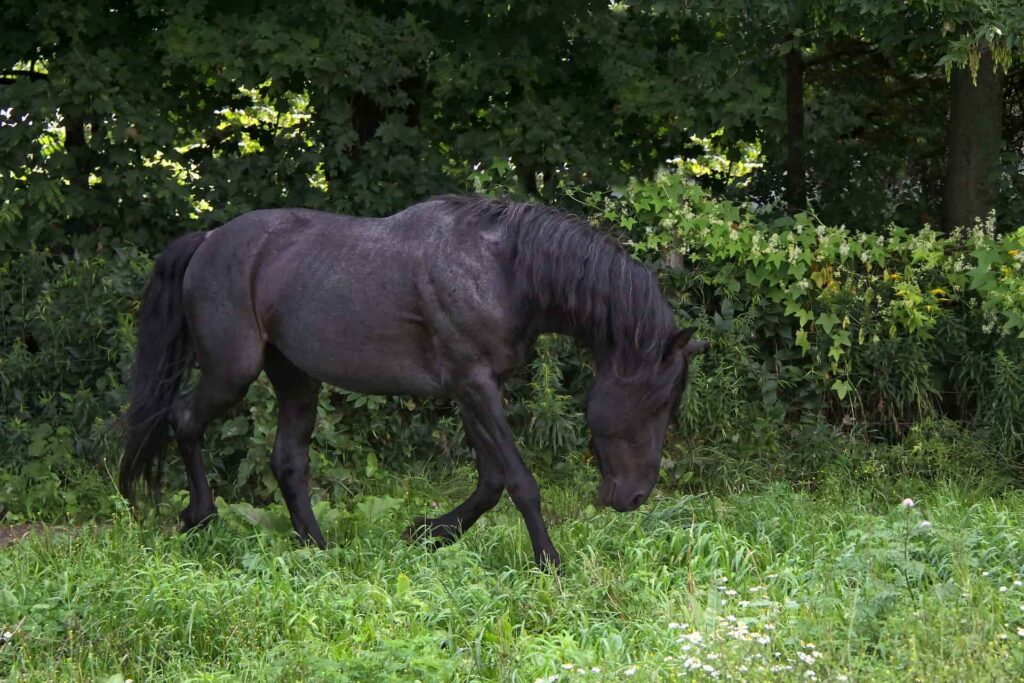
Roans are a color breed and not a true breed. So roan coats can occur in a variety of horses (although not all breeds) and in any color. True roan coloring can occur in any solid base coat (like black, chestnut, or bay) and in any diluted color coat (like champagne, silver, dun, and cream.)
And although the roan color can present itself with virtually any base color, the most popular roans are the red roan, blue roan, and bay roan.
Red Roan
When the white hairs mix together with a chestnut background coat, the resulting shade is called red roan. For light chestnut horses, the coloring may appear pinkish which has earned it the nickname ‘strawberry roan’. With darker chestnut coats, roaning may appear purplish, thus the name ‘lilac roan.’
Blue Roan
With a black base, blue roans achieve a bluish tinge when the black and white hairs intermingle. Also simply called ‘black roans’, the blue roan coat has to be the rarest of all the roans, making it a highly desirable colorway across various horsing communities.
Bay Roan
Although the chestnut horse and bay roan have similar, reddish brown coats, the bay roan has black points which the red roan doesn’t. Bay roans can thus manifest pinkish or purplish coats with black points, making for a very interesting appearance.
While these three represent the most iconic roan coat colors, roan coloration appears on virtually any coat color. When this occurs, the name simply follows the base coat. For instance, a palomino horse with a roan pattern would be called a palomino roan. Sometimes, they’re also called honey roan.
In cases when the base coat grows in a particularly light color like creamello or champagne, it’s possible that roaning might not appear as prominent. Points can seem the same color as the rest of the horse, making it harder to identify the roan coloring.
Aside from the base colors of the horse’s body, it’s also possible for the roan pattern to occur alongside a coat pattern. These include:
Dappling
This refers to the development of spots or dapples all over the horse’s coat (see the most beautiful spotted horse breeds). In non-roan horses, the dappling appears darker. But in a classic roan horse, the dapples will appear lighter than the rest of the body, made up predominantly of white hairs.
Pinto
Common to the American Paint horse, the pinto color breed may manifest side by side with a roan color. The white areas will often look solid white, while the areas of solid color showcase the silvering associated with roan coloration.
What are NOT Roan Horses?
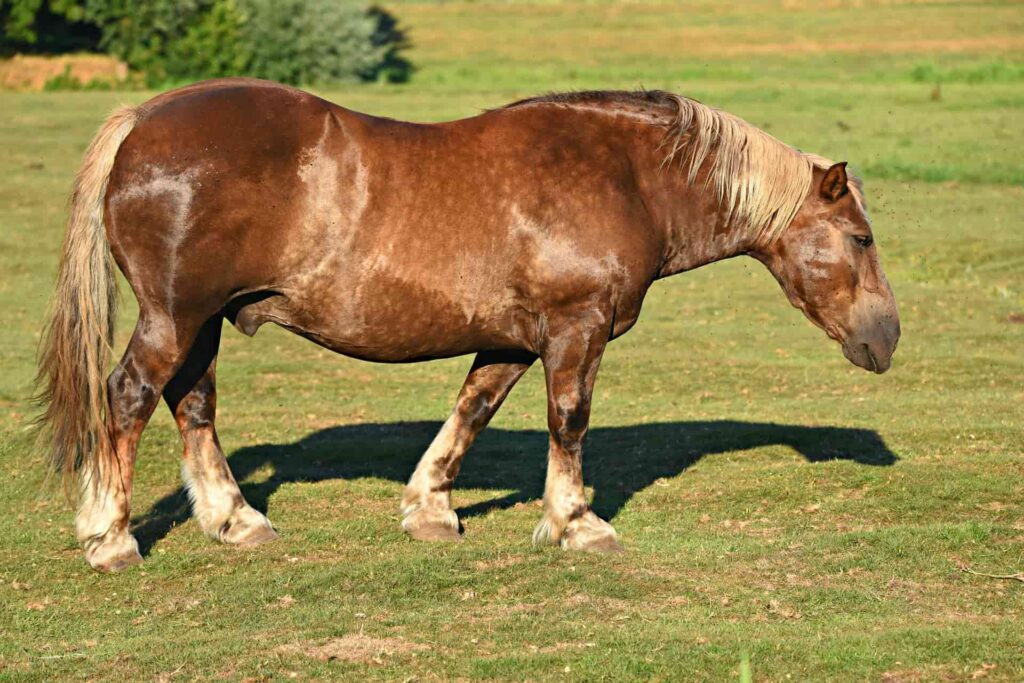
You’d be surprised how many horses look like roan horses but actually aren’t. These faux roans may even have the roan gene and may demonstrate roan like coat patterns, but because of the manifestation of roan pattern, they fail to qualify as true, classic roans.
Gray Horses
Unlike the classic roan which is born roan, gray horses start off with a solid colored coat. Over time however, as the animal ages, the foal coat sheds and loses pigmentation. This graying results to an evenly desaturated appearance all over the horse’s coat. That means the hairs become gray in color, as opposed to roans which combined white and colored hairs.
While it might look like a roan, this gray coat color will have no distinct differentiation from the horse’s points, lower legs mane and tail. That means even the head, ears, lower legs, and the base of the tail will showcase the same gray coat color.
Finally, with gray coats, animals become progressively lighter colored as they get older. As foals, there’s no indication that the horse will even have a future gray coat.
It’s even possible for grey horses to appear entirely gray from head to tail despite being born a different color. With roans, the coats don’t get lighter with age and may even become darker.
Varnish Roan
The ‘varnish roan’ term might seem like something of a misnomer because they’re not technically a classic roan. A varnish roan occurs as the result of the leopard complex coat color combined with the roan gene. In this case, the combination of colored and white hairs only appears on certain parts of the body.
In certain instances, white hair may even occur on the head and lower legs, which is typically excluded from the coverage of true roan coats. If the roaning only occurs on the rump, then the coat pattern is called a ‘varnish blanket.’ Bony parts of the face, legs, and hips remain solid in color. These areas are thus called ‘varnish marks’.
Rabicano
In rabicano horses, you’ll see apparent roan coloring with the same white hairs along the flank, belly, and the base of the tail. But because the white markings are concentrated in just these areas, rabicano horses do not qualify as classic roan horses that have equally distributed white hairs all over the body, except the points.
However because of the distinctive presence of white hair at the base of the horses’ tails, rabicano coat patterns are also called ‘skunk tail’. They may also present white hairs that band together to form vertical stripes along its ribs. Also called ‘white ticking’ in English, rabicano horse genetics aren’t entirely clear as of writing.
Sabino Horses
A sabino horse may present white spots on different parts of its body, but this doesn’t qualify as a true roan pattern. To get classified as a roan, the horse would have to have white and colored hairs equally distributed across its body.
But in the case of the sabino, white hairs converge in just one area, with white patches on other parts, creating a classic ‘cow-like’ appearance or pattern. This contradicts the basis requirement for roan coloration which requires the mixing together of white and colored hairs.
Frequently Asked Questions
What does roan mean?
Dictionary definitions of the word ‘roan’ simply explain that it pertains to a colorway of animals, particularly horses, which combines a solid base with white. Although it’s not entirely clear where the word roan comes from, some sources claim that it was taken from an old Spanish word meaning ‘red.’ On the topic of Spanish, see these beautiful Spanish horse breeds.
What color is a roan?
A classic roan horse can be any solid base color combined with white hair. The white roan hair strands are evenly and equally distributed across the body, creating a silvering effect. Save for the head and the animal’s ‘points’, the whole body manifests roan coloration.
What is a blue roan?
Although they appear blue at a glance especially when under certain lighting conditions, a blue roan horse actually isn’t blue at all. Instead, the white hair fibers contrast with its solid black base coat, creating the appearance of a blue coat.
What does a roan look like?
The distinctive quality of a roan is that it looks silver, perhaps even almost metallic. This sheen becomes especially pronounced as the horse’s coat reflects light. Depending on the background coat color, a roan may look blue, red, pink, purple, or even silver.
What is a bay roan horse?
By definition, a bay roan horse possesses a bay base color of bay horses which is identified by black points unlike the red roan which is chestnut all over. A dark underlying coat will appear more purple, while a lighter coat color can appear like a pink, strawberry roan. Nevertheless, a bay roan always have black points.
How much is a blue roan?
A lot of factors come into play to identify the right price for a blue roan horse. Its breed (examples of expensive horse breeds and the cheapest horse breeds), pedigree, and age are just some of the considerations worth taking into account.
The cheapest blue roan horses can sell for $800, while high quality horses can sell for as much as $10,000 or more.
How to get a blue roan foal?
To get a true blue roan from breeding, at least one of the horse’s parents would have to be a blue roan. Breeding a blue roan with a solid black horse may increase chances of getting a blue roan as well. But the best chances of developing blue roans would be to cross two blue roans together.
Can you breed two roan horses?
Yes, absolutely. Breeding two roans significantly increases the chances of producing a roan baby. Keep in mind though that when breeding heterozygous roan parents, it’s still possible to produce a non roan foal coat.
The Beauty of the Roan
Roan horses have undeniable beauty, majesty, and appeal that will keep them in high demand for the rest of their existence. But before you shell out big bucks on that potential roan, make sure to check the facts. Not all silvery horses are roans, and understanding the intricacies can save you from spending your hard earned cash on a faux roan.

